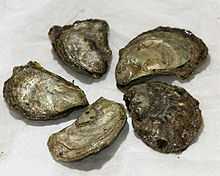Ostrea conchaphila
| Ostrea conchaphila | |
|---|---|
 | |
| Olympia oysters | |
| Conservation status | |
| NE[1] | |
| Scientific classification | |
| Kingdom: | Animalia |
| Phylum: | Mollusca |
| Class: | Bivalvia |
| Order: | Ostreoida |
| Family: | Ostreidae |
| Genus: | Ostrea |
| Species: | O. conchaphila |
| Binomial name | |
| Ostrea conchaphila (Carpenter, 1857) | |

The Olympia oyster, Ostrea conchaphila, is the native oyster of the Pacific coast of North America from Alaska to Mexico. The name is derived from the important 19th-century oyster industry near Olympia, Washington, in Puget Sound.
Distribution
Distinct from Ostrea lurida, which exists north of Baja California, O. conchaphila lives in the Pacific Ocean south of Baja California.[2]
Use by Native Americans
Native American peoples consumed O. conchaphila everywhere it was found, with consumption in San Francisco Bay so intense, enormous middens of oyster shells were piled over thousands of years. One of the largest such mounds, the Emeryville Shellmound, near the mouth of Temescal Creek and the eastern end of the San Francisco – Oakland Bay Bridge, is now buried under the Bay Street shopping center.[3]
Decline and return in California
O. conchaphila nearly disappeared from San Francisco Bay following overharvest during the California Gold Rush (1848-50s) and massive silting from hydraulic mining in California's Sierra Nevada (1850s-1880s). California's most valuable fishery from the 1880s-1910s was based on imported Atlantic oysters, not the absent native. But in the 1990s, O. conchaphila once again appeared in San Francisco Bay near the Chevron Richmond Refinery in Richmond, California.
Restoration efforts
Species restoration projects for the Olympia oyster funded by the US Government are active in Puget Sound and San Francisco Bay.[4][5] An active restoration project is taking place in Liberty Bay, Washington.[6] This Puget Sound location is the home of an old and new Olympia oyster population. Intertidal areas with native oyster populations or evidence of past populations are strong candidates for re-introduction.[7] The re-establishment of the population is currently threatened by the invasive Japanese oyster drill Ocinabrina inorata. This species preys on the oysters by drilling a hole between the two valves and digesting the oyster's tissues. O. inorata is a threat to the oyster especially in areas with low populations of the mussel Mytilis.
The Nature Conservancy of Oregon also has an ongoing restoration project at Netarts Bay, Oregon.[8]
References
- ↑ IUCN 2007. 2007 IUCN Red List of Threatened Species. <www.iucnredlist.org>. Downloaded on 28 September 2008.
- ↑ You Say Conchaphila, I Say Lurida: Molecular Evidence for Restricting the Olympia Oyster (Ostrea lurida Carpenter 1864) to Temperate Western North America, Maria P. Polson, Journal of Shellfish Research 28(1):11-21. 2009, downloaded March 2, 2012.
- ↑ Emeryville Shellmound, Sacred Sites International Foundation, March 1, 2004, retrieved 2010-09-11
- ↑ NOAA Awards $150,000 to Restore the Olympia Oyster in Puget Sound, NOAA, October 23, 2003, retrieved 2010-09-11
- ↑ Researchers working to restore population of Olympia oysters along California coast, San Jose Mercury News, August 1, 2010, retrieved 2010-09-11
- ↑ Recovery of the Olympia Oyster in Kitsap County, United States Department of Agriculture, Spring 2008, retrieved 2010-09-11
- ↑ "Reestablishing Olympia Oyster Populations in Puget Sound, Washington". Washington Sea Grant.
- ↑ Returning oysters to the bay, The Nature Conservancy, retrieved 2010-09-11